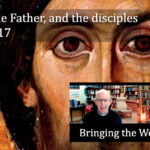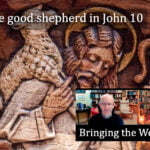The lectionary gospel readers for the Fourth Sunday of Easter take the three parts of John 10 in turn; being in Year A, we are reading the first ten verses. But this is a good example of where our modern chapter divisions (first created by Stephen Langton, the 13th-century Archbishop of Canterbury who helped to write the Magna Carta) hinder rather than help our reading, for two reasons.
First, John 10 actually straddles a fairly major division in the narrative. The events of chapter 6 are clearly situated near Bethsaida and around Lake Galilee—the feeding of the 5,000, Jesus walking on the water, and the dispute about Jesus as the bread of life. But in John 7.10, Jesus heads off ‘secretly’ to Jerusalem for the Feast of Tabernacles in the early autumn, one of the three Pilgrim Festivals (with Passover and Pentecost), and the action of chapters 7, 8 and 9 until 10.21 is set around this time. (Note the mention, for example, of the ‘people of Jerusalem’ in John 7.25 and the ‘temple guards’ in John 7.45; this is a reason why we might interpret the language of ‘the Jews’ (Judaioi) here as either ‘Jewish leaders’ or ‘Judeans’.) But in John 10.22, we have now moved to The Feast of Dedication (Hannukah), around two months later, without any note of the time passing. The intense focus on Jerusalem is one of the things that makes sense if we believe that the author of the gospel is a Jerusalem disciple, rather than one of the Galilean Twelve.
Secondly, the chapter change from John 9.41 to 10.1 disrupts the continuity of the narrative, and even breaks up a single speech by Jesus to the Pharisees that oppose him. Chapter 10 begins with the distinctive expression of the Johannine Jesus: ‘Truly, truly I say to you…’ (Ἀμὴν ἀμὴν λέγω ὑμῖν…). Since the Greek text here records the Aramaic or Hebrew term ‘Amen’, then we should really do so in English translations, as we do for other Aramaic terms like ‘Marana tha’, ‘Alleluia’ (in Revelation), and ‘Amen’ when it occurs in its usual place at the end of a prayer or praise to God. ‘Amen’ concludes numerous prayers in the OT, but only Jesus uses it to introduce his solemn statements. The single use (‘Amen I say to you…) occurs throughout Matthew and Mark, suggesting that this is a record of Jesus’ ipsissima verba, though Luke mostly omits the phrase in order to make his gospel more accessible to a non-Jewish readership (for example, compare Matt 8.10 with Luke 7.9). The Fourth gospel’s unique doubling of ‘Amen’, which comes 25 times, is usually repeated three or four times within a narrative unit, and almost always occurs in the middle of a section of discourse—and this is no exception.
Although we might casually infer that Jesus is opposed to the Pharisees as a group (‘I tell you Pharisees’, John 10.1 TNIV, supplying the word ‘Pharisees’ because of the context), the narrative of the healing of the man born blind in chapter 9 is connected tightly with the Good Shepherd discourse by the theme of division amongst the Pharisees in particular and the ‘Jew[ish leaders]’ in general. They are ‘divided’ in John 9.16, and again in John 10.19, and on both occasions in the same way—some saying he is opposed to God or possessed by a demon, but others arguing that he could neither do such healings or teach such things if he was a ‘sinner’. Difference and division is therefore central to the context of Jesus’ teaching here, and it is also emphasised in the content of what he says.
Part-way through Jesus’ discourse about the sheep/shepherd/sheepfold, the gospel narrator interjects to explain that this is a ‘figure of speech’, a paroimia. The term occurs only here and in John 16.25 and 29 in the gospels, and only once elsewhere in the NT in 2 Peter 2.22—where is has its usual Greek meaning of a proverb or saying. But both the terms parabole and paroimia translate the Hebrew term mashal in the Greek OT (the Septuagint, LXX), and we should not see this speech as very different from the parables in the Synoptics—which are other wise absent from the Fourth Gospel.
It was previously argued (by Joachim Jeremias in The Parables of Jesus) that parables had only one point, implying that anything more complex was a later addition by the early church or the author of the gospel. But that does not stand up to scrutiny in the light of Jesus’ own explanation, for example, of the parable of the sower in Mark 4. On the other hand, we should be wary of treating these as allegories, where each element of the story (such as the gatekeeper in this case) ‘stands’ for something, in a detailed one-to-one relationship. That approach is undermined by Jesus’ change of focus here, where at one moment he is the shepherd, and at another is the gate for the sheep—notwithstanding the fact that shepherds would at night lie across the entrance to a sheepfold to protect the flock. Jesus emphasis in verse 9 is that he lets people in, not that he keeps others out.
The ‘figure of speech’ here functions in the same way as the parables in the Synoptics, as Jesus explains by quoting Is 6.9–10 in Mark 4.10–12: the obscurity of Jesus’ teaching serves to differentiate between those who are spiritually open to receive his message, and those who fail to understand. In this context, the difference is metaphorically expressed as between those who see (including the man born blind) and those who remain blind to Jesus’ true identity, despite their claim to sight, that is, understanding.
The first part of the paroimia is simply descriptive of the practices of shepherd in Jesus’ day. There is often discussion here (and in relation to the shepherds at Christmas in Luke 2 as well as Luke 15) as to whether shepherds were social outcasts as the bottom rung of the ladder of respectability. But David Croteau has pointed out that all the negative references to shepherds either come from Greek sources or from one part of the Babylonian Talmud, which might have been influenced polemically against the gospel traditions in which shepherds are positive models. Within this narrative, and elsewhere in the NT, shepherds are depicted entirely positively—which is not surprising given the roots of the image in the OT as referring to God and to those who are faithful leaders under God of his people, especially in Ezekiel 34 and Ps 23.
First-century shepherds would indeed be able to name their sheep, who would respond to either a tune played on a flute by their shepherd, or the shepherd calling them by name. This was important, since it was common for several flocks and shepherds to share a sheepfold, which would indeed have a gatekeeper to ensure only those entitled could enter.
Jesus adds in the theme of division and conflict by contrasting the true shepherd of the sheep with those whose claim to the flock is illegitimate. Rather than coming in the correct way, he pictures them vaulting over the wall of the sheepfold, and causing havoc amongst the flock. The gospel’s Jewish readers are likely to hear in this echoes of what happened in the First Jewish War, which led to the destruction of the temple in AD 70; there was such division amongst the different factions that more Jews were killed by other Jews than were killed by the Romans. And the political rebellion against Roman rule led to the destruction of the people. Within the narrative, Jesus’ criticism of the Jewish leaders who oppose him is confirmed by the terminology: the High Priest’s courtyard in John 18.15 is referred to by the same term, aule, as the sheepfold, and Barabbas, chosen for release in preference to Jesus in John 18.40, is a ‘robber’. The leaders of the people literally choose a thief in place of the Good Shepherd.
In the second part of the paroimia, Jesus makes his identification with the shepherd and the door explicit, and this section includes, close together, two of the seven ‘I am…’ sayings of the Fourth Gospel. Felix Just notes how all these images are rooted in the OT, and primarily refer to God’s relationship with Israel:
- Bread of Life / Bread from Heaven – see Exod 16; Num 11:6-9; Ps 78:24; Isa 55:1-3; Neh 9:15; 2 Mac 2:5-8
- Light of the World – Exod 13:21-22; Isa 42:6-7; Ps 97:4
- Good Shepherd – Ezek 34:1-41; Gen 48:15; 49:24; Ps 23:1-4; 80:1; 100:3-4; Micah 7:14
- Resurrection / Life – Dan 12:2; Ps 56:13; 2 Mac 7:1-38
- Way – Exod 33:13; Ps 25:4; 27:11; 86:11; 119:59; Isa 40:3; 62:10
- Truth – 1 Kings 17:4; Ps 25:5; 43:3; 86:11; 119:160; Isa 45:19
- Vine / Vineyard – Isa 5:1-7; Ps 80:9-17; Jer 2:21; Ezek 17:5-10
So Jesus’ claims here contribute to the high Christology of this gospel; what God was to Israel, Jesus now is to those who follow him.
The description of the shepherd now takes on heightened significance. As the sheep, who are trusting, and unable to find their way on their own, listen to the voice of the shepherd, so Jesus’ voice becomes the guide for those who follow him. This literally becomes the case for Mary Magdalene in the tomb garden in John 20; it is when she hears Jesus call her by name that she recognises him. But elsewhere in this gospel, the voice of Jesus is closely identified with the voice of God; just as Jesus only does what he sees his Father doing (John 5.19) so he only speaks what the Father is speaking (John 12.49), so that to hear Jesus is to hear the words of God (John 14.31).
And to hear Jesus is to know him, and that is the source of true life (John 17.3). Here is the most striking contrast between Jesus as the good shepherd, and the ‘thieves and robbers’ who claim illegitimate authority. Where they bring death, he brings life—in fact, he offers an exchange, where he gives up his own life, and experiences death, in order that the sheep might have life ‘in all its fulness’. This, then, is not a mantra for general prosperity in society, detached from the question of discipleship (as it appears to have been used recently in the Church of England statement about goals in education), but an expression of discipleship—of the life that comes from Jesus’ atoning death, that brings light and life to those who receive him. This completes the connection between life and sight that is created by the connection with the healing of the man born blind; right at the start of this gospel, the Word brings life which is the ‘light of all humanity’ (John 1.4) but which is only experienced when he is ‘received’ (John 1.12).
These sayings do not, therefore, offer a cosy image of comfort to those already part of the community of faith, nor to the general reader. They are generated in the heat of the conflict and division created by both Jesus’ teaching and his actions. They sit within the paradox of grace and judgement within this gospel as a whole; although Jesus came to save the world and not judge it (John 3.17), yet judgement comes when people make a decision about how to respond to Jesus (John 3.18). Jesus’ claim to be the true Shepherd of God’s people means we need to make a response as to whether we will follow him.
But to those who do receive them, these words offer hope and life. Safety is no longer to be found in a place, in the sheepfold of the land of Israel or the social space of conformity to the law, but in a person—in the knowledge of Jesus and obedience to the call of his voice, as he calls us by name. Hence Paul’s language of the people of God being ‘in Christ’ where the OT talks about being ‘in the land’. And the sheep belong to the shepherd, they are his own, because they have been ‘bought with the price’ (1 Cor 6.20) of the life of the Good Shepherd laid down for us.
Join Ian and James as they discuss all these issues and bring some contextual insights from the work of Kenneth Bailey.





























Yes this “paroimia” is an extended conceptual metaphor—such metaphoric imagery is the language of theology—but many (most?) theologians (like the original disciples?) do not seem to understand them or their significance. Thus, The Cambridge Handbook of Metaphor and Thought (2008) has 28 articles from “distinguished scholars from different academic fields” ranging through science, law, mathematics, psychoanalysis, music, and art—but theology is not represented.
Robert Masson comments:
“Recent developments in understanding …. in the interdisciplinary field of cognitive linguistics provide fresh ground for rethinking how God and religious beliefs are conceptualized … While research groups of the Society of Biblical Literature in recent years have devoted some attention to the implications of metaphor theory in cognitive linguistics for the interpretation of ancient texts, this research has only just begun to reach the broader public … These challenges of cognitive linguistics’ to standard accounts of metaphor and figurative language have not been seriously addressed in theology and religious studies—indeed, have hardly been noted except for some recent work in biblical hermeneutics.
Robert Masson, Without Metaphor, No Saving God: Theology after Cognitive Linguistics (SPT 54; Leuven: Peeters, 2014), 111.
—he explores mind-stretching concepts about how metaphors convey and ‘create’ truth.
Thank you for another interesting article and discussion. You guys put a lot of work into these each week 🙂
It occurs to me that an echo of sheep listening to the voice of the Good Shepherd is found in John 18:37; viz Jesus answered, “… the reason I was born and came into the world is to testify to the truth. Everyone on the side of truth listens to me.”
To hear the truth one has to actively listen and be searching for the truth.
Glad you enjoy them!
I think you are right. These basic ideas (of listening/hearing, truth, following) are intertwined in the Fourth Gospel.
Thank you Ian,
I may be reading too much into this, but what is interesting in the Greek is that the word order is SHEEP-VOICE, SHEEP-VOICE and SHEEP-VOICE (probata-phones, probata-phonei and probata-phonen). So that reading from left to right the voice of the shepherd is always ahead, and the sheep are always following. Another interesting thing to note is that the gap between the word for sheep and the word for voice is different each time. Also probata is ‘one that walks forward’.
I’m no expert in Greek but I think the sheep-voice pairings stand out more clearly than they do in English, and make for a nice 3-point sermon!
Sam
To clarify – v3-4
Here is a link to an artwork I did recently. It’s called Jacob’s Ladder.
In it you will see many theological themes: The Alpa and the Omega; the Ladder; The Gate Keeper; Goin up and Down; Going In and Out; Peter’s Exhortation-“Make every effort”; Pauls Exhaltation. “Self-Control”.
Some of the inspiration came out of Ian’s recent blogs. Thanks Ian.
https://www.dropbox.com/s/p34zklguc8p3fgo/jacob%27s-ladder%202.jpg?dl=0
You are veritable artist, sir. Well done !
Well, thanks Pellegrino,
Much appreciated.
The Vulgate transliterated “Amen Amen” as “Amen Amen” . So also the Douay & New American Bible Revised among English versions. See also the following modern German language versions: the BasisBibel, the Einheitsubersetzung, the Leonberger, & Zurcher. It’s interesting that the BasisBibel which uses simple German kept “Amen Amen”.
Ross, thanks for this. I noticed the Douay, but was surprised so few other ETs do this. The NET Bible, which is often good, even has its notes wrong and claims the Greek says ‘truly’!
None of the German (or Italian or Spanish) translations I have do this, so the BasisBibel is an even more interesting case.
thanks
‘The leaders of the people literally choose a thief in place of the Good Shepherd.’
For some reason I always had a picture in my head of a crowd of Jewish people calling for Barabbas to be released, rather than just the Jewish authorities. Perhaps I was influenced by Jesus of Nazareth film?
Are the sheep that Jesus refers to in John only Jews?
The sheep that are “not of this fold” are Gentiles !
Who do you think Jesus is referring to when he says “All who have come before me are thieves and robbers…” in verse 8?
My first response is to say those false leaders of Israel, the failed shepherds, who have led the people astray. Does that make sense?
Yes it does and that was my inclination but the “all” seems very all-encompassing and was wondering if in some way it even included the patriarchs and prophets who although pointing to Jesus are in some way still implicated by sin and therefore subject to judgement but that might be a bit harsh!
I dont see how it could apply to them given Jesus used them as an example in a parable of the people who came before the son, but they too were ignored.
‘The thief comes only to steal and kill and destroy’ – that hardly applies to God’s prophets.
Yeah, I know, I was just kicking it around because as I said the “all who came before me..” seems rather all encompassing and was just chewing on it out loud
Perhaps Jesus was referring to would be political messiahs, zealots, patriots, insurrectionists etc..
I feel that Ezekiel Ch.34 is a good commentary on John Ch. 10. A salutery warning to shepherds and a great comfort to His sheep.
Thanks for pointing Ezekiel 34 out. Jesus is the Good Shepherd, the David, the Son of Man and also, not forgetting, the Land too.